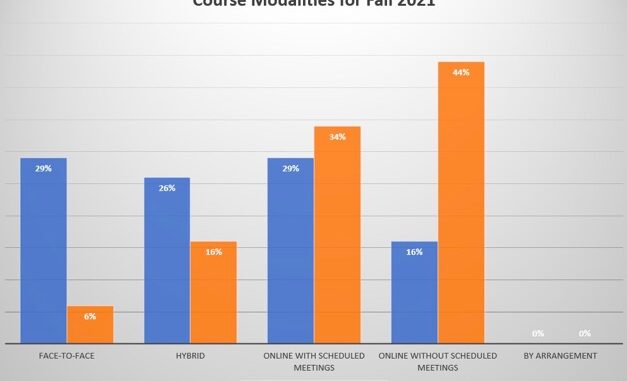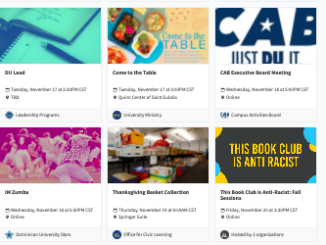
Dominican University’s plan for Fall 2021 involves seeing more students on campus as there will be a shift towards in-person learning with more face-to-face and hybrid courses.
On March 23, I talked with Jeffrey Carlson, provost and vice president for academic affairs, to hear the updates for Dominican’s plan for Fall 2021.
For Fall 2021, Dominican’s course modalities for undergraduate and graduate students will be a mix of face-to-face, hybrid, and online with and without scheduled meetings. For undergraduate students, 29% of their courses will be face-to-face, 26% will be hybrid, 29% will be online with scheduled meetings and 16% will be without. For graduate students, 6% of their courses will be face-to-face, 16% will be hybrid, 34% will be online with scheduled meetings and 44% will be without.
Carlson cannot guarantee that these modalities will not change since Dominican is continually trying to be responsive and balance what is best for achieving course learning goals and figuring out what is safest for the university.
“As external circumstances change, we may continue to refine the modality mix for the Fall courses that begin five months from now,” Carlson said.
Carlson had been working with Student Success and Engagement (SSE) to figure out what would be in the best interest for students during the Fall 2021 semester because students who struggle generally do better with face-to-face instruction.
SSE has been analyzing student success rates considering courses students have dropped, withdrawn, or failed in the Fall 2020 semester. The SSE staff has also been analyzing academic alerts that faculty submit for students.
These findings and assumptions went into Carlson’s decision-making for the Fall.
The schedule for the Fall 2021 semester is now posted for students to start preparing their schedule and meeting with their advisors. Registration for graduates will be the week of April 5 and undergraduates will register the week of April 12.
According to a veteran teacher, a course that needs a face-to-face modality is Introduction to Computer Applications.
“It translates better in-person and I think it’s very difficult to teach a student some of the software when you can’t look at what they’re doing, and you can’t see their placement of their hands on a keyboard. It is a hard thing to pull apart when you are not together,” said Ellen Alamilla, a lecturer in Computer Science.
Alamilla teaches four Introduction to Computer Application courses. Three of the classes are hybrid while the other is fully online.
In her face-to-face hybrid courses, Alamilla provides help for her students by having them raise their hand. She will then stand behind them maintaining her distance and watch what they are doing to assist them with their problem.
For her online course, Alamilla is very explicit with her directions. She said she tries to keep a positive and encouraging attitude with her students.
Through both types of courses, Alamilla shares her screen so students can watch what she is doing. She has also increased her office hours and will meet with students on the weekend to allow them to talk through any problems or questions they may have.
Alamilla also prefers face-to-face classes because she enjoys getting to know her students and building a relationship with them. She had a conversation with one of her students from outside her office.
“You can see that even though they’re wearing a mask they’re genuinely happy to see you and you’re happy to see them. That’s everything for me,” Alamilla said.
Students also want to have that face-to-face communication with their instructors.
“It’s easier to get to know a professor face-to-face rather than online. It’s harder to make connections with professors online,” said Susan Garcia, a business major.
Garcia gauges the difficulty of a class before deciding what style to take. If a class is difficult, it should be face-to-face, but if a class is manageable, it can stay online.
“Last semester, it was really hard when it came to my accounting class,” Garcia said. “I felt that this class had to be face-to-face. I wanted to ask my professor for clarification, but when it’s online, they don’t really see you. Instead, they just proceed with the class.”
Garcia believes that Dominican is turning into “Zoom University” meaning that she is not receiving what she would get if she were in face-to-face classes.
Carlson said that no matter the style of delivery – or modality – the goal is the same. “We have to get every student to meet the learning outcomes that a course was supposed to deliver,” he said.
Along with the Fall 2021 schedule, the Spring 2022 schedule will also be posted.
For Spring 2022, Carlson encourages faculty to try to think what post-COVID would look like. Do we hop right back into our normal schedule or do we take what we learned from online and hybrid learning and keep that as we move forward?
amariotti@my.dom.edu



